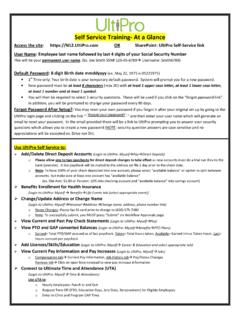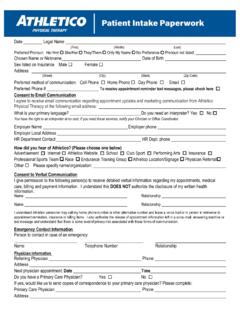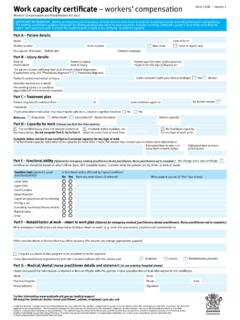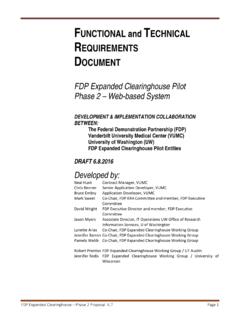Transcription of Understanding and Interpreting an FCE
1 Understanding and Interpreting an FCEAn FCE needs to be objective, non biased, evidence based in order to be fair to the injured worker and referral source. The goal is to obtain a valid FCE Other Common Test Names Work Tolerance Screening (WTS) functional Abilities Evaluation (FAE) functional capacity Assessment (FCA) Work capacity Evaluation (WCE)FCE Purpose-Provides objective data to assess Capabilities and Limitations The report needs to answer the referral question???? Is the patient giving effort that is maximum or near maximum effort in order to accurately determine: Work Status Work Placement Settlement Determine next course of action Surgery Other medical interventions Missed diagnosisA Physican should avoid placing arbitrary restrictions on abilities without objective assessment and measurementFCE Assesses Validity/Reliability Consistency of Effort Quality of effortPROBLEM: What do we do when the patient does not give good objective effortWho Should Perform an FCE?
2 May be dependent on state practice act guidelines Needs to be a provider who has the clinicalexpertise and can legally provide a clinical opinion Analyze, interpret and conclude by answering referral question Provider needs to be objective/non biased-Should not be treating clinician Provider needs to have knowledge to consider all components (medical history, current medical condition, etc) Occupational TherapistWho Should Perform an FCE?The FCE needs to be defensible in courtCheck the signature lineIndicators for FCEM edical Job involves repetitive work task Job involves Medium to Heavy work Complaints of pain with no substantiated clinical findings Plateau in PT/OT MedicaI(MMI) Decreased work toleranceBehavioral Off from work 3 months or more Loss of past work habits and self-confidence Fear of re-injury Negative attitude about returning to work Questionable legitimacy of injury Suspected sub-maximal effort Lack of progress in physical/occupational therapy without clear objective reasoning Lack of participation in therapyLegal Objective documentation needed to return to work Return to work will require job modification Conflict of medical opinion about worker s statusPatients referred for FCE & WCE need to medically stable.
3 Resting HR greater than 100 bpm Blood pressure not greater than 160/100 Pain has stabilized Able to tolerate activity-2 hours Soft tissue healing will not jeopardized with maximum tolerance testing Stages of High Blood Pressure in AdultsStages Systolic And/OR Diastolic Prehypertension 120-139 OR 80-89 High Blood Pressure Stage 1 140-159 Or 90-99 High Blood Pressure Stage 2 160 or higher Or 100 or higher 11 FCE Approaches Psychophysical Approach:Subjective complaints determine progression of tolerance is not based on the presence or absence of mechanical changes or deficits is in charge of the testing process. Kinesiophysical Approach: Athletico (previously Accelerated) Mechanical changes or deficits need to correlate with the subjective pain complaints. Kinesiophysical Approach cont d. Evaluator Determines stopping point Based on the observation of mechanical changes which should be observed when max effort is given.
4 Based on our medical knowledge of biomechanics, diagnosis, physiology, anatomy, & cardiovascular endurance If Client terminates task before a mechanical change is noted and or kinesiophysical signs are observed, , it can be assumed that maximum effort was not given on that specific task. Different Types of FCE s (should be part of the referral question) Baseline FCE Assessment of the functional ability to perform the spectrum of work tolerances related to the physical demand factors of job tasks Best suited when restricted duty is available or RTW to previous job is highly improbable MMI, disability, vocational re-training/assessment Job-specific FCE Assessment of the match between the client s functional capabilities and the critical demands of a specific job Answers the referral question - Can the client return to work to the previous job? Accomplished by evaluating work tolerances with specific parameters and the use of structured work simulations Different Types of FCE s Cont.
5 UE FCE Initiated with M-S Eval Assessment of only the physical capabilities and tolerances that incorporate UE usage Will not evaluate sitting, standing, stoop, squat, kneel, crouch, etc. The referral source should speak to the therapist upon making the referral so the evaluation is scheduled with the most appropriate therapist. 161718 Value of Providing Job Description for Job-Specific FCE Provides accurate parameters for RTW Ensures that client will only be assessed on tolerances specific to job Ensures that the evaluator will be able to establish recommendations, which are appropriate and reasonable for the job/employer Accurate job description is critical Goal: request a functional job description with job demands at time of initial evaluation If no job description is available, therapist receives job information from the Injured Worker Athletico can send a copy of this form to the employerName: _____Signature_____Job Title_____ Employer _____Do you have a case manager?
6 _____If Yes, Please provide contact information:_____ LIFTING: What is the heaviest item you typically lift at work from floor to waist level? _____ How much does it weigh?_____ How often do you lift this item/object? (Please check box) 1-100 times/day (12/hr) 1 101-500 times/day (12-62 lifts/hr) Greater than500/day (over 62/hr) Are there items you lift which are lighter than above that you lift more frequently to waist level? How much does it weigh?_____ How often do you lift this item/object? (Please check box) 1-100 times/day (12/hr) 1 101-500 times/day (12-62 lifts/hr) Greater than500/day (over 62/hr) What is the heaviest item you typically lift at work to shoulder level? _____ How much does it weigh?_____ How often do you lift this item/object? (Please check box) 1-100 times/day (12/hr) 1 101-500 times/day (12-62 lifts/hr) Greater than500/day (over 62/hr) What is the heaviest item you typically lift to overhead level?
7 _____ How much does it weigh? _____ How often do you lift this item/object? (Please check box) 1-100 times/day (12/hr) 1 101-500 times/day (12-62 lifts/hr) Greater than500/day (over 62/hr) CARRYING: Do you carry items with two hands? Yes_____ No _____ Describe Item _____ How much do the items weigh? _____ How far do you carry the item? _____feet How often do you carry the items? (Please check box) 1-100 times/day (12/hr) 1 101-500 times/day (12-62 lifts/hr) Greater than500/day (over 62/hr) Do you carry items with one hand? Yes_____ No _____ Describe Item _____ How much do the items weigh? _____ How far do you carry the item?_____feet How often do you carry the items? (please check box 1-100 times/day (12/hr) 1 101-500 times/day (12-62 lifts/hr) Greater than500/day (over 62/hr) PUSH/PULL: Do you push or pull items at work?)
8 _____ If yes, do you use a cart to push or pull items?_____ If you use a cart, describe how much weight is on the cart? _____ Please check the boxes below if you have to get in the positions while at work 0% Never 1-33% of the work day Occasional 34-66% Of the work day Frequent 67-100% of the work day continuous Squat Kneel Crawl Run Climb Stairs Climb Ladders Above Shoulder Reaching Below Shoulder Reaching 21 Need to know if patient can do this task when they return? ---Job Specific-Need Job DescriptionEvaluation Process-How long does it take?What is assessed? 4-6 hours in duration Review medical record Important to get accurate description of injury and review medical records (Previous therapy, surgeries, history, etc) Pain and activity/disability questionnaires Gain insight to why observed limitations may be disporportionate to objective finding. Musculoskeletal evaluation Non material handling assessment-repeated movements Objective functional testing-lifting/carrying/job sim Repeat testing of 1 & 2 hand lifting performance-throughout FCE confirms abilities Job Simulation Tasks or functional Circuit-confirms ability previously assessed during the FCEWhy is a M-S Evaluation important as part of an FCE Should be part of all FCEs-Check with your provider Determines whether client meets admission criteria MS evaluation allows Evaluator to distinguish between limitations in performance due to impairment or lack of effort without any MS findings to support the observation Is there a correlation?
9 Evaluator may not know why (fear, anxiety) Ex: Knee diagnosis: may have difficulty getting into a full squat due to limitations in ROM. (FCE evaluator would not know this if they did not measure it during a MS evaluation Assists in predicting functional performance Client may need good PT before proceedingEvaluation: Physical Tolerance Testing- Floor to Waist 12 to Waist Waist to Shoulder Shoulder to Overhead Non material handling Activities Sitting, standing, reaching, kneeling, squatting, bending, ladder, stairs, Balance Assessment Static and DynamicJob Simulation Tasks/ functional Activity Circuits Performed to assess tolerance to perform tasks outside of standard lifting parameters Job Specific functional Activity Circuit Usually 30-60 minutes Verifies weights observed during formal tolerance testing, assesses endurance, allows evaluator to make recommendations for work tolerances. How do you know if the client is exerting a good effort which is representative of their abilities?)
10 Skill of evaluator-ask !!!!! Battery of tests Observation throughout FCE Walking into the facility Sitting tolerance while filling out paperwork Pain and Activity Questionnaires Assess clients perception of their pain and disabilityObjective testing Musculoskeletal exam Function testing Circuit/Cross Reference lifting The greater the number of battery of tests, the more likelihood to observe consistent behaviors. 27 Critical FCE Metrics-Every FCE methodology has internal rating system-No standardMetrics: Consistency of Effort Reliability of Pain/Performance Quality of Effort Most CommonAthletico has 3 areas of objective measurement that is gathered during the assessment. Many testing methodologies combine it into 2 3 Effort Metrics Definitions Consistency of Effort= Reproducibility -or thelikelihood thatan effort may becopied,duplicated, or produced as a close imitation, in a series of trials. Quality of Effort = Degree -or the extent, level, or scope of a subject's volitional exertion in maximal or repetitive testing.









